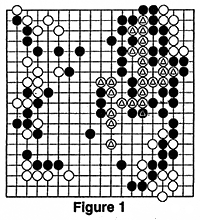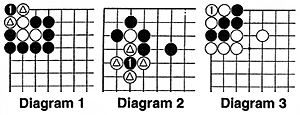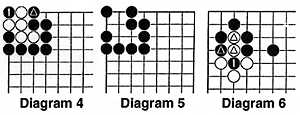Cho Chikun defends Kisei title
On March 11, Cho Chikun beat Koichi Kobayashi in the sixth game of the best-of-seven Kisei title match to win this title for the fourth consecutive time and eight times altogether. Through his victory in this most prestigious of title matches, Cho left no doubt in anyone's mind that he is Japan's strongest player.The match started out with Cho winning the first two games. Kobayashi won the third, but Cho won the fourth. Therefore, Kobayashi had to win the next three games to take the title. Kobayashi won the fifth game, and, in the sixth, he had a good position after Cho made a strategic mistake in the transition from the opening to the middle game.
But Cho fought back by invading the huge territory that Kobayashi had mapped out. Cho's invading group, surrounded on all sides by Kobayashi's stones, had to either make two eyes to live or link up to one of its allied groups. After a series of subtle moves by both players, Cho skillfully linked up his endangered group to one of his secure groups, then went on to eke out a 5.5-point win.
 Figure 1 shows the position after 127 moves. Kobayashi has just played the marked black stone, and the marked white ones are in danger of being captured. After a series of subtle moves, Cho managed to link them up to his secure group of stones in the bottom righthand corner.
Figure 1 shows the position after 127 moves. Kobayashi has just played the marked black stone, and the marked white ones are in danger of being captured. After a series of subtle moves, Cho managed to link them up to his secure group of stones in the bottom righthand corner.
In spite of this setback, Kobayashi is clearly at the height of his go strength. At the end of last year, he won the Tengen title, on March 6 he won NEC Cup and he is challenging Naoto Hikosaka for the Judan title. (Kobayashi won the first game of this best-of-five match.)
Cho on the other hand appears unbeatable. Besides the Kisei title, he holds the other two top titles--Meijin and Honinbo--making him a "triple-crown champion" of Japanese go, a position he has held for the last three years. In May, he will defend his Honinbo title for the 10th straight time, but no potential challenger from the league is likely to give Cho much trouble.
If you are interested in seeing the Kisei title match games, they are posted on Yomiuri's Web site at: http://www.yomiuri.co.jp/index-e.htm. Scroll to features and click "Kisei Title Match."
Answer to last week's problem
 In Problem 11, you were asked to capture the two marked white stones. The correct answer is for Black to cast a net with Black 1. If White tries to break out with 2, Black blocks with 3, and White has no way to break out into the open. If he plays 4 (or A), Black 5 (or B) puts the white stones in atari. Black cannot capture the white stones with a ladder. It is wrong to play the sequence to 5 in the next diagram, because of the marked white stone. White 6 threatens to capture Black 3. If Black plays 7, White captures a stone with 8 and Black's position collapses.
In previous columns, we studied various capture techniques. First of all, I would like to review the rules of go that we have introduced so far.
In Problem 11, you were asked to capture the two marked white stones. The correct answer is for Black to cast a net with Black 1. If White tries to break out with 2, Black blocks with 3, and White has no way to break out into the open. If he plays 4 (or A), Black 5 (or B) puts the white stones in atari. Black cannot capture the white stones with a ladder. It is wrong to play the sequence to 5 in the next diagram, because of the marked white stone. White 6 threatens to capture Black 3. If Black plays 7, White captures a stone with 8 and Black's position collapses.
In previous columns, we studied various capture techniques. First of all, I would like to review the rules of go that we have introduced so far.
Rule 1. The board is empty at the start of the game.
Rule 2. Black makes the first move, after which he and White alternate.
Rule 3. A move consists of placing a stone of one's own color on an empty intersection.
Rule 4. A stone or a solidly connected group of stones of one color is captured and removed from the board when all the intersections directly adjacent to it are occupied by the enemy.
Illegal moves
A corollary of the last rule is that you are not allowed to place a stone on an intersection that is not connected to an empty adjacent intersection. In other words, you are not allowed to commit suicide.
   
|
White is not allowed to play 1 in Diagram 3 either. This move would result in a three-stone white group without any liberties.
When capturing stones, however, you are allowed to play such moves. For example, if Black has played the marked stone in Diagram 4, then Black can play 1 because this move eliminates the liberties of the five white stones. The result of this capture is shown in Diagram 5. Likewise, if Black has already played the marked stone in Diagram 6, he can play at 1 and capture the two marked white stones.
Living groups
We are now going to show you a group that can never be captured. The white group in Diagram 7 is completely surrounded by black stones, but it cannot be captured. The reason is that it has two internal points at A and B (Diagram 8) called eyes. Black cannot play on either of these two points because it would be an illegal move. Therefore, the white group can never be captured since the points A and B leave this group with two liberties. The points A and B are called "eyes." From this, we can define a living group: a group is alive if it can form two eyes.Look at the white group in Diagram 9. It may seem as if this group has two eyes, but this is not the case. It has only one eye and this is called a two-point eye space. Black can kill the white stones by playing at 1 in Diagram 10. If White captures this stone with 2 in Diagram 11, White is left with only one eye and Black can play at 3 in Diagram 12 and capture the five white stones.
 Problem 12.
Problem 12.
White to play and make two eyes. If it were Black's move, where would he play to capture the white stones?
